AWUNDERFULL-AWUNDERFULL: God - I love this pic. It was probably taken around 1944 (the year I was born). But it so reminds me of my early days on this planet; the clothes, the house, the dog.
The girls are (left to right) MaryAnn and Alice Mae Thompson. The little boy is Larry E. Howell. Both girls have passed away now. The house still stands on the west side of Perry Street. It is the second house north of the railroad tracks. It’s recently been remodeled.
At the time this pic was taken Larry and his parents lived next door (to the right in the photo). And to the left was the Charles Trinter home where later the Farrell and the Ream families lived. Across the street (the house in the background of the pic) was where Vermilionite Dale Wendel lived. Dale’s mother was a Leidheiser. And more than once Dale has told me that his mom used to mend nets during the winter in that home. It, like the old Tarrant home (just across the tracks to the south), is gone now.
This pic was among those given me by Major Jack Corcino (MaryAnn’s son) last year. As ye can see - not everybody on earth lived in sparkling new homes (like many do today). But life wasn’t quite as dismal as it may seem to some.
The kids in the pic were quite happy. And so was their pooch.
Wistfully,



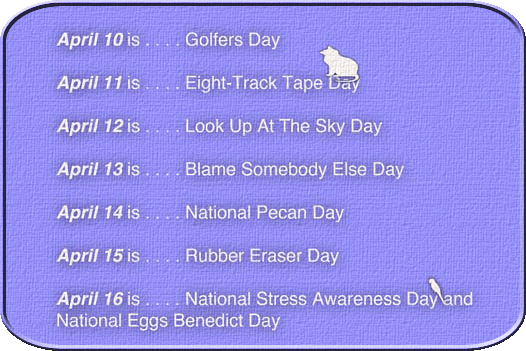


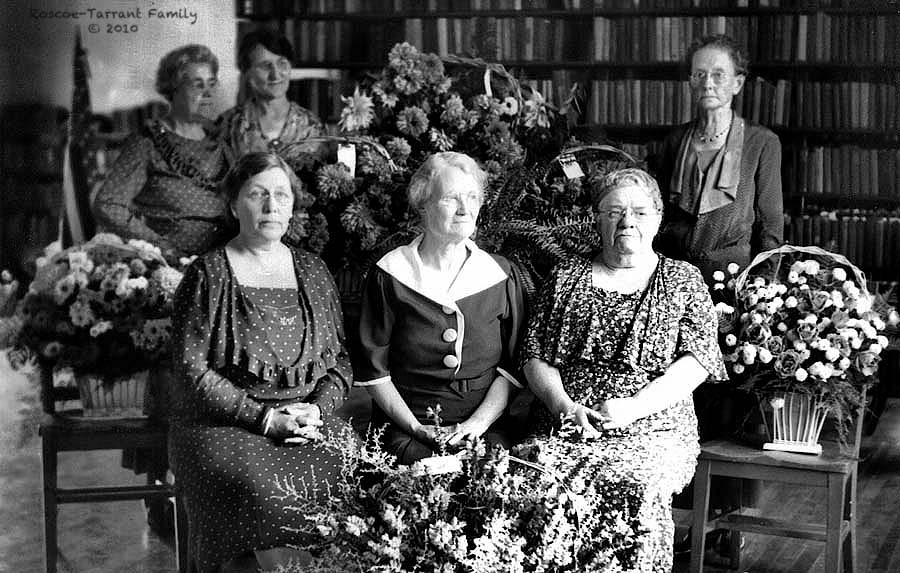
Vermilion Public Library Board members - October 19, 1935
THE VERMILION PUBLIC LIBRARY - JUST A BEGINNING : In 1817, the Ohio General Assembly enacted legislation providing for the incorporation of public libraries. It was a nice gesture. But that’s about all it was. Because the legislation provided zero financial support.
Things got a little better in 1853 when “The School Act” codified local tax support for public schools, This legislation provided that some of those funds could be also used to create school libraries that would be open to the public
And then - moving right along - in 1869 legislation was passed authorizing Ohio municipalities to open and maintain free public libraries. While this legislation made it possible for communities to apply for Carnegie grants in the early 1900s it was not until 1933 that public libraries in Ohio received any real support. That support was generated from revenues realised from the intangible personal property tax. This was a tax levied on individuals’ holdings of intangible assets – mainly stocks and bonds. Although the tax was state-imposed and applied evenly throughout Ohio, it was collected locally, and the funds remained in the county of origin. They were distributed to library systems in each county in accordance to “need.”
Throughout most of the 19th and the early years of the 20th centuries Vermilion’s public library consisted of but a few tomes occupying the shelves a village dry goods store. The books were both donated, and cared for, by some very “kind and public-spirited citizens”. Although Ohio laws had years before made it possible for various organizations to sponsor a library, and maintain an operating budget it was not until December 17, 1918 that the Vermilion Library Board (of Trustees) was formally organized and appointments to it made.
A.C. Hofrichter, the president of the Board of Education, appointed Miss Bertha Nieding, president, and Mrs. Pearl (Bessie) Roscoe, vice president. Mrs. Walter Smith was named as secretary; and Mrs. Evert C. Thompson, treasurer. Mrs. I. H. Shaw, Miss Addie Rust, and Reverend H. C. Lynch made up the rest of the library committee. Mrs. Paul Buttner served as librarian.
Initially the newly organized library operated out of a small building on the east side of Grand Street just north of the railroad tracks. The building had once been the home of local photographer Rudy Moc’s Sunset Studio. In 1935 - after 17 years of savings made on purchases, work done gratis by board members, and interest earned on savings - a new facility was built on the site.
Much of the unskilled labor was provided by the Federal Emergency Relief Administration (FERA) a program designed to alleviate adult unemployment during Franklin D. Roosevelt's presidency. The skilled labor was accomplished by some local artisans under the supervision of a local contractor - W.A. Tischer.
On Saturday, October 19, 1935 the Vermilion Public Library was officially opened to the public. From just a handful of books on a shelf in a dry goods store it now housed over 7,000 books and magazines. To many folks it must have seemed like a task well done. No one, of course, realized it then - but it was just a beginning.
Ref: Vermilion Centennial and South Shore Regatta 1837-1937; The Vermilion News 1/17/35, 10/17/35; Ohio Public Funding History from the Ohio Library Council; Roscoe-Tarrant Family Photo Archive; Published in the Vermilion Photojournal 9/04/09; Written @ 12:11 PM - 8/30/09.



PEACE WALK
PAINTING THE TOWN: As previously mentioned this is a preview piece for a new webpage that I am currently developing. Using a new software program in conjunction with Adobe's Photoshop CS4 I am able to take some already wonderful pix of Vermilion, O. and make them (at least in my view) more "wonderfuller"
If you love the beauty and quiet of the Ohio woodlands this be the place to stop and rest your bones for a moment. This is the beautiful wood just above the Olympic Outing Club in Brownhelm Township, Ohio. While these quiet shadows were captured early last summer it is always a pretty - a pristine - place to visit. Someday some ambitious contractor will likely buy the property, remove the trees, and erect houses on the land. So enjoy it whilst it lasts.
From Rich Tarrant's "Painted Vermilion" -
Apr 9, 2010 11:49 AM.
Beautiful.

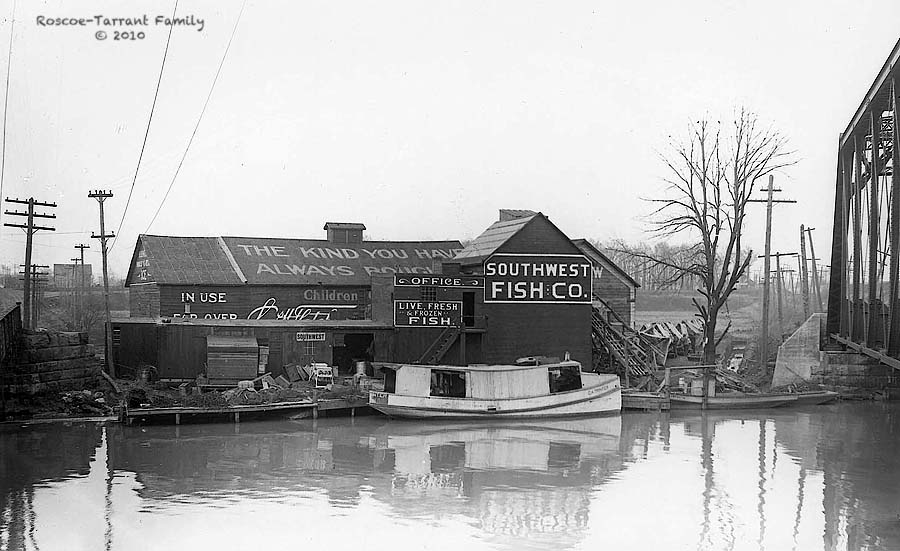
"...it was not impossible for a single load of booze from Canada
to bring in $10,000 for any person bold enough to dodge a few machine-gun bullets..."
HOW PROHIBITION HELPED COMMERCIAL FISHING: During the early years of the 20th century the numbers of Lake Erie freshwater herring and whitefish harvested by commercial fishermen were on the decline. Industry statistics show that the herring catch went from eleven million pounds in 1919 to six by 1923. Whitefish went from two million to less than four hundred thousand. Both types of fish were high-value, high-profit commodities and this nosedive in production for the fishing industry was both an unexpected and devastating development. In essence it was caused by a combination of things; a rapidly changing environment; commercial exploitation; and the absence of any coherent fishing management agreement among the states and the Canadian province bordering the lake. Given these circumstances the consequence was - at least in retrospect - no big surprise. And then along came a thing called “The Volstead Act”.
The Volstead Act was a piece of legislation passed by federal legislators in 1919. It enabled the United States government to enforce the 18th Amendment to the U.S. Constitution, and is formally known as the “National Prohibition Act”. Under the 18th Amendment, intoxicating liquor was essentially “prohibited” within the United States. In the meantime, across the lake in Ontario, Canada a law had been enacted that made drinking alcohol illegal while the manufacture and export sales of alcoholic beverages was perfectly legal.
Now, the aforementioned circumstances combined with the fact that Lake Erie was the longest unprotected border in the world opened the door for a new kind of commerce on the lake; smuggling. [Pictured is the tug “C.A. Trinter” docked in front of the Vermilion's Southwest Fish Co during Prohibition.]
Before organized crime (most notably Detroit’s Purple Gang and Chicago’s Al Capone) assumed control over a vast majority of rum-running operations on the lakes some small operators in the numerous towns and villages scattered across the northern shore of the lake naturally took some advantage of the situation. And some stories indicate that Vermilion, O. had at least a small role in these spiritual escapades. For it was not impossible for a single load of booze from Canada to bring in $10,000 for any person bold enough to dodge a few machine-gun bullets while navigating his vessel at top speed through a thick fog, or during the dead of night. Yet however glamorous that may seem, more often than not, most smuggling operations were somewhat less profitable and uneventful. The bottles were simply placed in the bottom of fishing totes beneath a small catch of fish and ice and brought to port.
One story of those times told by local resident Hank Fischer recounts a time when a load of booze destined for Sandusky came into port. Authorities had roadblocks set up on nearly every road between Vermilion and Sandusky to intercede with any such shipments. But the fellow in charge of shipping them westward was confident that he could accomplish the task without a problem.
He was so confident that he asked some of the locals if they would like to put a wager on the task. Everyone of the locals saw a great way to make a few bucks, and laid their money on the line.
When the bets were down the bootlegger packed the booze in his vehicle, and called a tow-truck. The tow-truck came and hauled his vehicle with the booze inside to Sandusky without a problem.
Another story concerns a rather substantial load of illegal alcohol that was uncovered by Vermilion’s Marshall. To safeguard the booty for the night it was placed in the lockup at the back of the Vermilion Township Hall. When the Marshall came to collect the evidence in the morning it had disappeared. Further investigation revealed nothing.
Toward the end of 1933 the 18th Amendment to our Constitution - which had probably created more problems than it ever solved - was dismantled. And oddly enough the interlude was of some benefit to the fishing industry. The pause had allowed the watery fields of Lake Erie to be replenished. And that is how "Prohibition" helped preserve commercial fishing on Lake Erie in a yesteryear.
Ref: Midnight Herring, Prohibition and Rum Running On Lake Erie, David Frew, 2006; Lake Erie Fishermen, Work Tradition and Identity, Lloyd and Mullen 1990; Special Thanks to Vermilion Area Archival Society, Roscoe-Tarrant Photo Collection; Published in the Vermilion Photojournal 12/04/98; Written 11/30/08 @ 2:40 PM


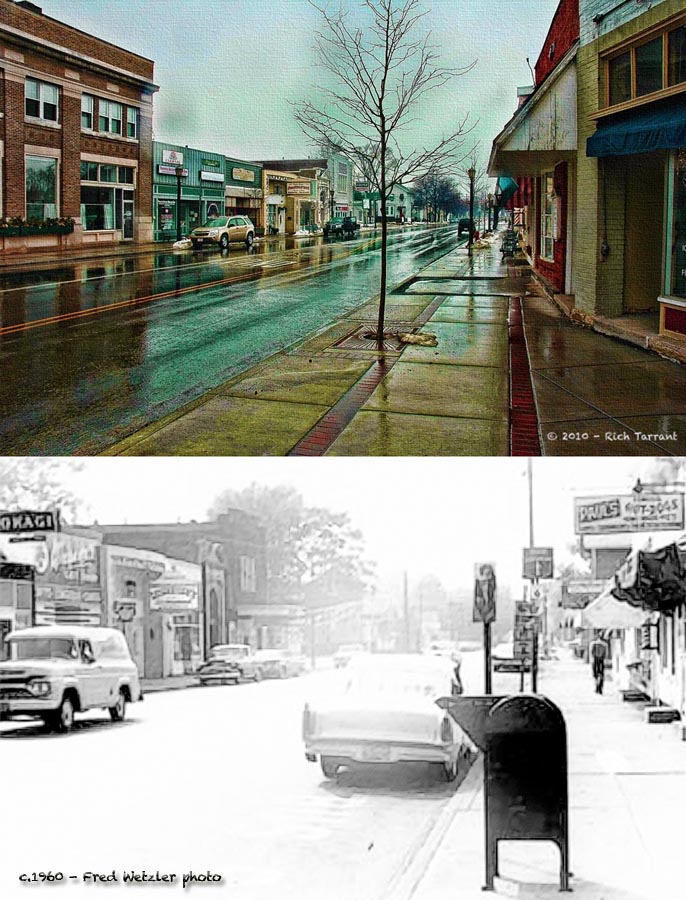
nothing ever remains quite the same...
SOMETHING OLD - SOMETHING NEW: The idea for this piece began as an idea for a coffee-table book of historical photographs of Vermilion, Ohio and, hopefully, it will (someday) be realized.
Originally the concept - as previously stated - was just a picture book. But after mentioning such a project in an issue of my weekly web page - Vermilion Views - a reader by the name of Scott Dommin suggested that it might be interesting if it featured photographs of how people, places, and / or things in the City of Vermilion, Ohio appear today along with photos showing how they appeared in the past. Ergo; the title "Now & Then".
"What a great idea." I told both myself and Scott.
[NOTE: Currently I'm weighing two proposals. Nothing's easy as it seems.]
Here we see Liberty Street looking west today, and the scene as it looked in 1960. With the exception of the barber shop (you can see the barber's marker on the right in both pix) all of the shops along the street have changed during the last half century. The Plymouth convertible in the lower pic belonged to Bill Peters. It was a beautiful customized car. Bill was the eldest son of Frank Peters and his wife who owned and operated the Favorite News Stand and Greyhound Bus Station that was located in the store-front now occupied by Burke's Real Estate business. A short time after this pic was taken Bill and another Vermilion boy (Jacob Boone) were involved in a terrible accident on Colorado Avenue in Lorain, Ohio. The car was totaled. Jake was not hurt. Bill was hurt very badly, but he did make a full recovery.



"This township was named after the principle river emptying into the lake through its territory..."
THE FIRE-LANDS: I found the following information re: the early inhabitants of our area to be extremely informative. Methinks you will also.
I am getting better at transcribing these passages so there are fewer mistakes. But I like to read as I go - and sometimes I fill in the blanks. So tread carefully this trail through yesteryear.
HON. ALMON RUGGLES
Few, if any, of the early pioneers of this country, are more deserving a place in history, and none filled more prominent and important positions, or had more varied and interesting experiences, than did the subject of this sketch. He came to this country from Danbury, Connecticut, to survey the "Sufferer's Lauds," so-called, in 1805. His first surveys were made under orders of his principal, and proved unsatisfactory to the committee, and he was then chosen by the committee as chief, and the survey was made the second time, to the satisfaction of all concerned. In this survey he called to his aid Judge Wright, of New York, who had charge of one branch of the work. In addition to his salary, he was permitted to select one mile square any where on the lake shore, within the limits of the Fire-lauds, at one dollar per acre. He selected the land,—a portion of which is now owned by his only surviving son, Richard Ruggles, on the lake shore, in the township of Berlin. The beautiful grove, known as "Ruggles' Grove," was spared by his order, and is now a fit monument to his memory, and in sight of which his ashes repose.
He was an expert swimmer. When it became necessary to cross a stream he could not ford, he would tie his wardrobe into as small a bundle as possible, cross the stream with them, and return for his compass.
His father was Ashbel Ruggles, a descendant of one of three brothers who came from Scotland, but just what year is not known. His mother was a Bostwick. Almon was a twin. His brother Alfred died in infancy. His father was in indigent circumstances when he was a boy, and he went to live with an uncle, who was a Presbyterian deacon, and very parsimonious. He refused to give young Ruggles an education, or to even give him an opportunity to acquire one. He obtained his first book by catching wood chucks, tanning the skins, and braiding them into whip-lashes for the market. As Providence helps the man who helps himself, so this young man was prospered. Six months was the sum of his school days, yet by application, he fitted himself for teaching, and taught in
an academy for some time. The very obstacles to be overcome, gave him that energy and strength of character which ever after characterized his public and private life. He was a self-made man in the best sense of the word. His own early struggles with poverty, gave him active sympathies with the poor pioneers of this country. All regarded him as a friend, and many of them depended on liim for support in all emergencies. He had a store of general merchandise, and trusted all those who could not pay. It is said of him that he might have been very rich
had he been disposed to grind the face of poverty. He preferred to live more unselfishly, and merit the confidence and respect of his fellows. He not only encouraged the early settlers with material aid, but with cheerful looks and kind words. He was alway jolly, and enjoyed fun, and all enjoyed his society. He represented this" senatorial district in the State legislature in 1816-17-19, when the district consisted of the counties of Ashtabula, Geauga, Portage, Cuyahoga and Huron, and in 1820, when it consisted of Cuyahoga and Huron. He was associate judge for several years, under the old constitution. His ability, his integrity, his knowledge of the country and people, eminently qualified him for the places he filled, and it is said of him, that in all his public life, no official misconduct stained his record, or cast a shadow on his character. He was an earnest worker in the whig party, and a personal friend of General Harrison. He was twice married. His second wife was a widow, Mrs. Rhoda Buck nee Sprague. He has two living children: Mrs. Dr. Phillips, of Berlin Heights, and Richard, who married Miss Eleanor E. Post, of Berlin. He lives on the homestead. Charles married Miss Mary Douglass for his first wife, and Miss Julia Mallory for his second. He was a member of no church, but was equally liberal with all, opening his dwelling for meetings and for the entertainment of the ministers. He was too large a man for wrongdoing, and too liberal and kind to treat any with incivility. Such a life never ends, so long as grateful children and grandchildren walk in its echoes. Such men can walk fearlessly and confidently down into the great future to meet whatever awaits them there. He passed in to the ''Beyond”, July 17, 1840, in the sixty-ninth year of his age.
 EARLY DESCRIPTI0N OF VERMILLION TOWNSHIP
EARLY DESCRIPTI0N OF VERMILLION TOWNSHIP
This township was named after the principle river emptying into the lake through its territory, and is bounded on the north by Lake Erie; south by Florence and Berlin Townships; east by Brownhelm township, Lorain county; and west by the township of Berlin. The surface of the township is level in the northern portion, while in the south part it is broken with alternate sandy ridges and low lands. The soil is variable, and embraces sandy loam, gravel and clay marl. Numerous stone quarries abound in the township, which produce an excellent quality of stone. Iron ore has also been found in paying quantities.
STREAMS
These are the Vermillion, La Chapelle, and Sugar creek. The first and largest of these rises in Ashland count; runs north through the eastern part of the Huron and western part of Lorain counties, emptying into Lake Erie near the east line of Vermillion township. It was named by the Indians, in consequence of a paint who they found along its banks. Sugar creek was so named from the fact that a mound stood at its mouth which resembled a sugar loaf, and also that the Indians made sugar from the extensive sugar orchards along the stream. La Chapelle rises in Huron county, and passes through the townships of Wakeman, Florence, and Vermillion.
[NOTE: The Fire-Lands became Huron County in 1809, and in 1838 the Ohio Legislature split the land to create Huron and Erie Counties. Erie County is named in honor of the Indians that inhabited the area in earlier times, as well as in honor of the Great Lake it borders.]
Author: Williams, W. W. (William W.)
Subject: Huron County (Ohio) - History; Huron County (Ohio) - Biography; Erie County (Ohio) - History; Erie County (Ohio) - Biography
Publisher: Cleveland, Ohio: Press of Leader Printing Company
NOT IN COPYRIGHT
Continued Next Week...
God Bless their souls - each and every one.

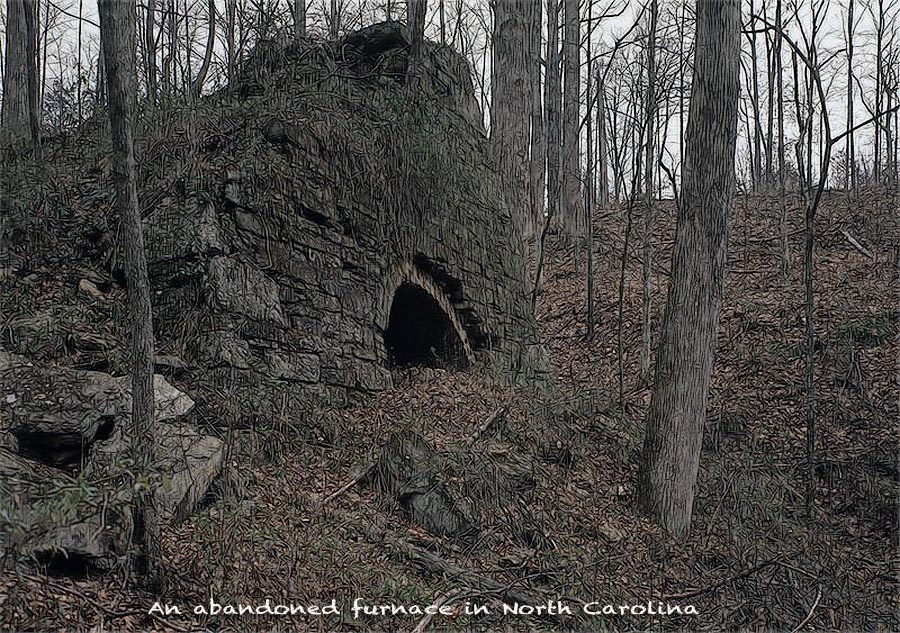
"That which is left is the stone shell of the Ironmaster’s office, the stump of a once great furnace,
and a few piles of slag now overgrown with vines, weeds,
and covered with the leaves from the forest grown wild and wonderful around it."
THE HURON IRON COMPANY OF VERMILION, O.: There’s a plaque near the northwest corner of Darrow and Vermilion-Savannah (a.k.a. State Route #60) Roads which, quite noticeably, goes unnoticed by most passers-by. In a nutshell it tells the story of a day when the community of Vermilion, O. - then part of Huron County - was an iron producing region. Although local residents have long referred to the spot as “Furnace Corners” the root of the appellation - the reason for its being called “Furnace Corners” has become as nearly obscure as the ruins of the old plant itself. Now but a shell of hand-hewn stone (pictured), its wooden bones long turned to dust, only the office building remains as a passing curiosity to an occasional hiker and to the diverse and sundry denizens of the Ohio woodlands which surround it. What took place here in just a yesteryear is - almost - forgot.
In the year 1834 three men - most notably Messrs. Ford, Sanford, and Tracy - from the Geauga Iron Company formed the Huron Iron Company. They apparently chose the area just south of the soon to be incorporated Village of Vermilion because of its proximity to bog iron ore and other deposits found beneath the nearby lake ridge formations.
Bog iron ore refers to impure iron deposits that develop in bogs or swamps by the chemical or biochemical oxidation of iron carried in the solutions. It was discovered during the Pre-Roman Iron Age, and most Viking era iron was smelted from bog ore. It was widely sought in colonial America, and during the American Revolution it was used by the military forces to manufacture cannon balls. It was also used in the manufacture of various castings used in ship building, wrought iron railings, cooking and heating stoves, plows, kettles and a plethora of miscellaneous household and farm implements. There was, therefore, not only a tremendous need for these items in colonial America, but also the post-Revolution America - which included the settlement and development of our community.
Consequently the proprietors of the Huron Iron Company constructed a blast furnace for the manufacture of such items south of town. Lined with native sandstone it was 30 feet high and 9 feet in diameter. Bog ore came from the nearby Scott farm. Charcoal was obtained from the surrounding forest, and limestone came by barge from the Sandusky area. The limestone was, interestingly enough, unloaded at piers in the lake off what is currently Sherod Park, and then trucked by horse and oxen to the iron works at Furnace Corners.
In 1835 Wilkeson & Co. purchased the operation and continued manufacturing items for the next two decades. But by 1855 improvements in shipping on the Great Lakes made obtaining a better grade of ore from the upper regions of the nation a less onerous task and the old furnace was abandoned.
At this time a Cleveland doctor by the name of Philo Tilden built a new furnace along the Vermilion River in the area just west of the current home of the Vermilion Boat Club. Tilden’s operation employed some 60 men. But it only lasted for ten years. And unlike the operation at Furnace Corners - nothing is left of Tilden’s company.
That which took place at Furnace Corners was more the norm than the exception in 19th century America. If the market wasn’t saturated with the products produced by the ironworks, the local supplies of raw materials to make them eventually ran out, and the Ironmasters moved on to another locale. That which is left is the stone shell of the Ironmaster’s office, the stump of a once great furnace, and a few piles of slag now overgrown with vines, weeds, and covered with the leaves from the forest grown wild and wonderful around it. And two-tenths of a mile east of these ruins on the northwest corner of Darrow and State roads there is an historical marker which, like the place and time it celebrates, goes largely unnoticed.
Ref: Text of “Dedication of Historical Marker - Route 60 - Vermilion, June 14, 1969; Special Thanks to Al Tarrant and the Vermilion Area Archival Society; Published in the Vermilion Photojournal 10/23/08; Written 10/19/08 @ 12:44 PM.



BORED OF THE SAME OLD TWO-PARTY SYSTEM? CHECK OUT THESE
ACTUAL POLITICAL PARTIES THAT EXIST OR EXISTED.
THE RHINOCEROS PARTY - This Canadian Party existed with a very unusual platform. It included: repealing the law of gravity, paving the province of Manitoba to create the world's largest parking lot, providing higher education by building taller schools, instituting English, French and illiteracy as Canada's three official languages, making bubble gum the national currency, putting the national debt on Visa, counting the Thousand Islands to make sure none were missing, and banning lousy Canadian winters.
BEER LOVERS PARTY - This post-Soviet assembly was founded in 1993 in the state of Belarus. Among its major goals was the push for the cleanness and quality of the national brew. Its logo was a cartoon of a drunken hedgehog. The party was liquidated in 1998.
THE ABSOLUTELY ABSURD PARTY is another Canadian joke party which advocates the following: Lowering the voting age to 14 (Because, after all, when was the last time a 14-year-old started a war?), changing the rules in federal elections so that the candidate in last place becomes the elected official, raffling off Senate seats as a fundraising mechanism, and replacing the Department of Defense with a crack elite squad of Rock/Paper/Scissors commandos.
THE UNION OF CONSCIENTIOUSLY WORK-SHY ELEMENTS was an unusually successful frivolous political party founded by comedian Jacob Haugaard in Denmark in 1979. Haugaard eventually won a seat in the Danish Parliament by making the following campaign promises: Tail winds on all bicycle paths, better weather, better Christmas presents, more pieces of Renaissance furniture in Ikea, Nutella in Army field rations, more bread for ducks in the park, and free beer and sausages, funded by his state party funding, served to his voters in the public park in Aarhus after each election. (The last three were actually fulfilled during his term in office.)
THE HUNGARIAN DOUBLE-TAILED DOG PARTY is a joke political party that was founded in 2004. All of the candidates are named Istvan Nagy, two very common first and last names in Hungary. While not an officially registered party, it nevertheless made the following promises in the 2006 elections: Eternal life, world peace, one-day work weeks, two sunsets a day, smaller gravitation, free beer and low taxes.
THE McGILLICUDDY SERIOUS PARTY is a joke party in New Zealand that promotes the following: Replacing the Royal New Zealand Armoured Corps with mounted knights, replacing money with chocolate fish as legal tender, using beer as a national defense strategy by leaving many bottles on all beaches so any invading army would abandon its attack and get drunk instead, restricting the vote to only those under 18 (with actual campaign ads run during children's programming), votes for trees (as New Zealanders have a reputation as environmentalists), air bags for the New Zealand Stock Exchange (in case of a crash), good weather (but only if the voters behave), job creation by carpeting the nations highways, and the sending-out of intelligence agents around the world to wipe New Zealand off published maps so no one could invade the country.
THE DONALD DUCK PARTY is a Swedish joke political party that received write-in votes before it even existed. Capitalizing on its popularity, one man, Bosse Person, registered it. He is its only member. In 1991, the party received 1,535 write in votes by promoting a platform which advocated free liquor and wider sidewalks.
THE HAPPENING HAPPY HIPPY PARTY was a spoof political party that was really more a Web site and "e-zine" that ran in the late '90's and early '00's. It promoted easing the burden on Britain's National Health Service by making accidents illegal and improving Britain's climate by towing the island 200 miles south.
THE MARIJUANA PARTY actually exists and is a current US political party that runs candidates who - you guessed it - work tirelessly toward the legalization of marijuana!
THE YOUTH INTERNATIONAL PARTY was a highly theatrical and anti-authoritarian political party that existed in the US in the 60's. Its members were called "Yippies." Better known for street theatre and politically themed pranks that mocked the status quo (such as running a pig as its candidate in the 1968 Election and throwing money out to the crowd at the New York Stock Exchange), this socialist countercultural organization was amusingly dubbed the "Groucho Marxists."




Podcasts - "forever under construction..."
PODCAST #175: This week the Vermilion Views Podcast #175 is really and truly worth watching. The first part is a very brief history about Cleveland, Ohio. The second is something Vermilionite Jim Fischer sent me - and for music and dance lovers it's a great deal of fun. If you like "Boogie-Woogie" you'll certainly enjoy this...
Also note that I've mucked-upthe numbering of these podcasts. Don't ask how I accomplished that task - but I did. I will try to correct that by next time.
Persons interested in the history of the Lake Shore Electric Railway (which was the subject of a recent past podcast series) - "the greatest electaric railway system on the planet" may want to go to Amazon.com and purchase a book called "Images of Rail - Lake Shore Electric Railway". It was put together by Thomas J. Patton with the help of my friends Dennis Lamont and Albert Doane. It'd make a nice gift.
Also, please note that all the video (MP4) podcasts (when used) are done in the "Quicktime MP4" format. If you don't have "Quicktime" it's easy to find and free to download.
NOTE NOTE:Past podcasts are not available in the on-line archive. They just take up too much disk space. But if one really, really, really wants to acquire a copy of a past cast it can be had by contacting me and I will place it on a disc and send it to ye for a minimal fee.


LOCAL ANNOUNCEMENTS: After giving it much thought this link has been "put-down". During the last year most of the folks who used to use this page as a bulletin board have acquired their own and, consequently, no longer need this forum from "Views". I have, however, kept links (in the links section) to Larry Hohler's "Hope Homes" in Kenya - and to Bette Lou Higgins' Eden Valley Enterprises sites. They are historically and socially relevant projects. I suggest that you visit these sites on a regular basis to see "what's shakin'".

Pay particular note to the "Hope Homes" page during the next few months. They are constantly improving the lives of their youngsters and those around them. This is an exciting project accomplished by exciting people.
Although this years Vermilion High School Class of 1959 reunion is over classmates may want to stay connected with each other through organizer Roger Boughton. Ye can connect by mailing him @ 2205 SW 10th Ave. Austin, MN. 55912 or you can just emailRoger.
Where's Alice? I found this link interesting. You just never know what Vermilion expatriots are up to - or where their up to doing it. Alice Wakefield is one of those people. So check out his link. Methinks you'll be surprised: Talking Turkey.


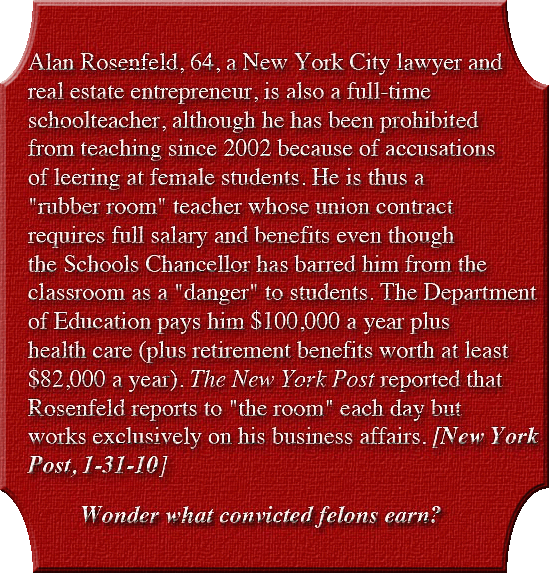







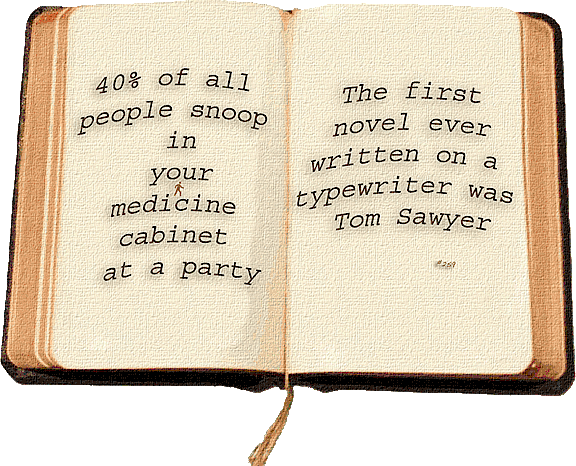





The Beat Goes On: The page is generated by the dreaded Macintosh Computer and is written and designed by (me) Rich Tarrant. It will change weekly ~ usually on Saturday. Bookmark the URL (Universal Resource Locater) and come back at your own leisure. Send the page to your friends (and enemies if you wish). If you have something to share with those who visit this page, pass it on. And if you see something that
is in need of correction do the same. My sister, Nancy, is a great help in that respect. It only takes me a week to get things right. And follow the links. You might find something you like. If you experience a problem with them let me know. Also, if you want to see past editions of this eZine check the new archives links below.

If you're looking for my old links section (pictured) I've replaced it with a pull-down menu (visible in the small box next to the word "Go"). If you're looking for links to more Vermilion history check that menu.

How the old links menu looked


For Persons who would like to donate to the cause (to keep these "Views" on-line you can send whatever you would like to me at the following address. And THANKS to everybody who has already donated to the cause. I doth certainly appreciate it):
Rich Tarrant
1041 Oakwood Drive
Vermilion, Ohio
44089
Telephone: 440-967-0988 - Cell: 440-522-4459
or you can use PayPal: (NOTE: IT WORKS NOW)

"In a democracy, dissent is an act of faith."
-James William Fulbright
Vol.8, Issue 4, April 10, 2010
Archive Issue #369
Vermilion Views Search Engine


© 2009 Rich Tarrant
